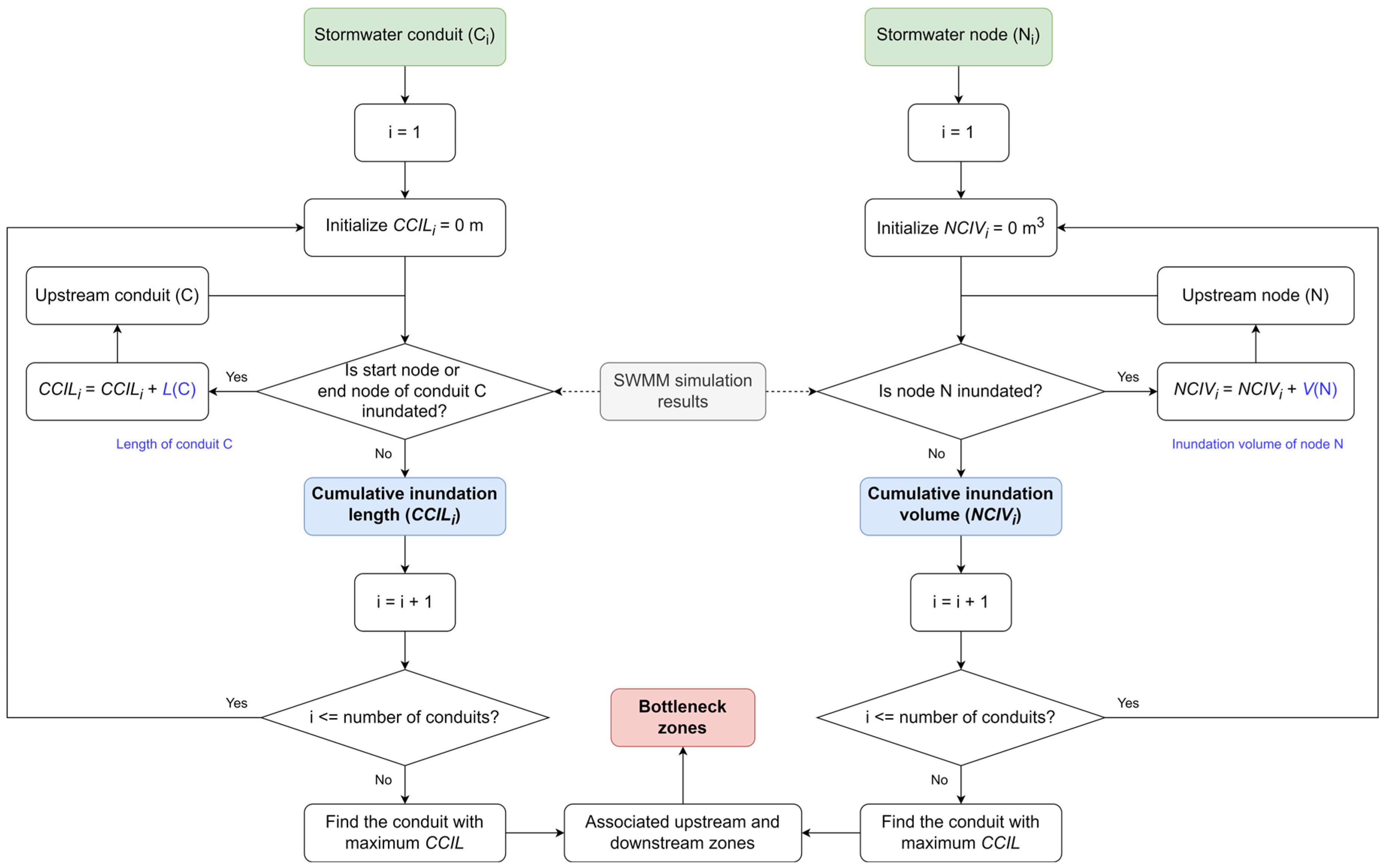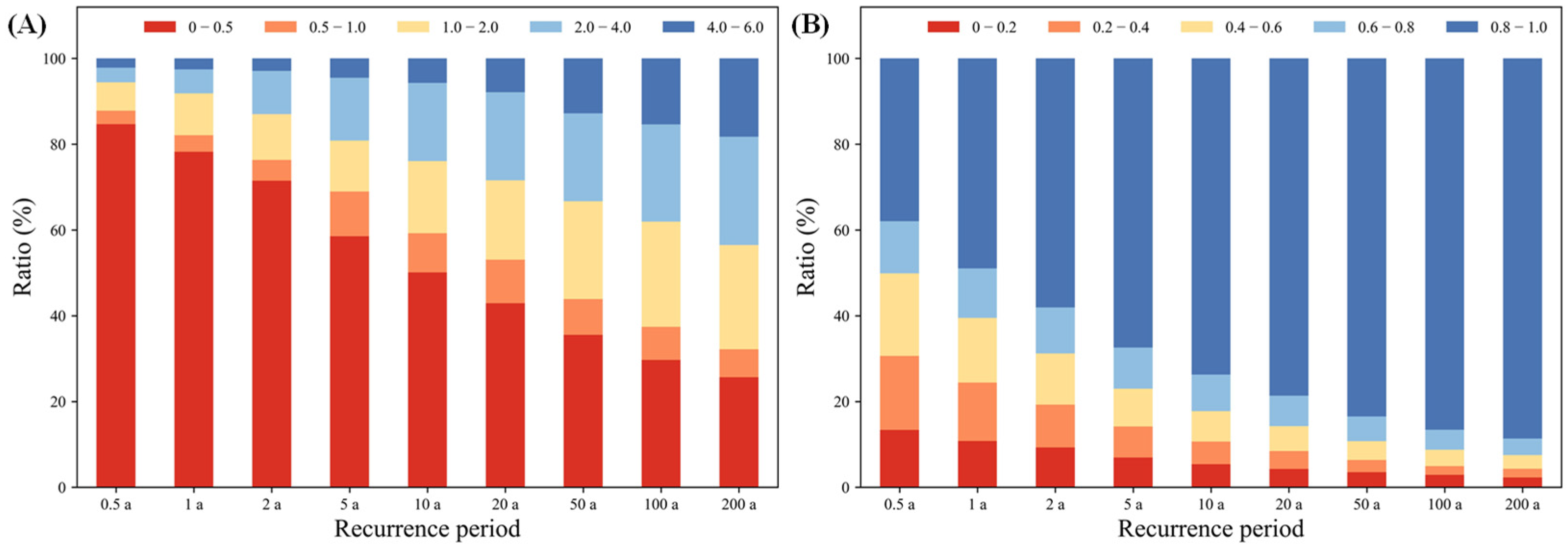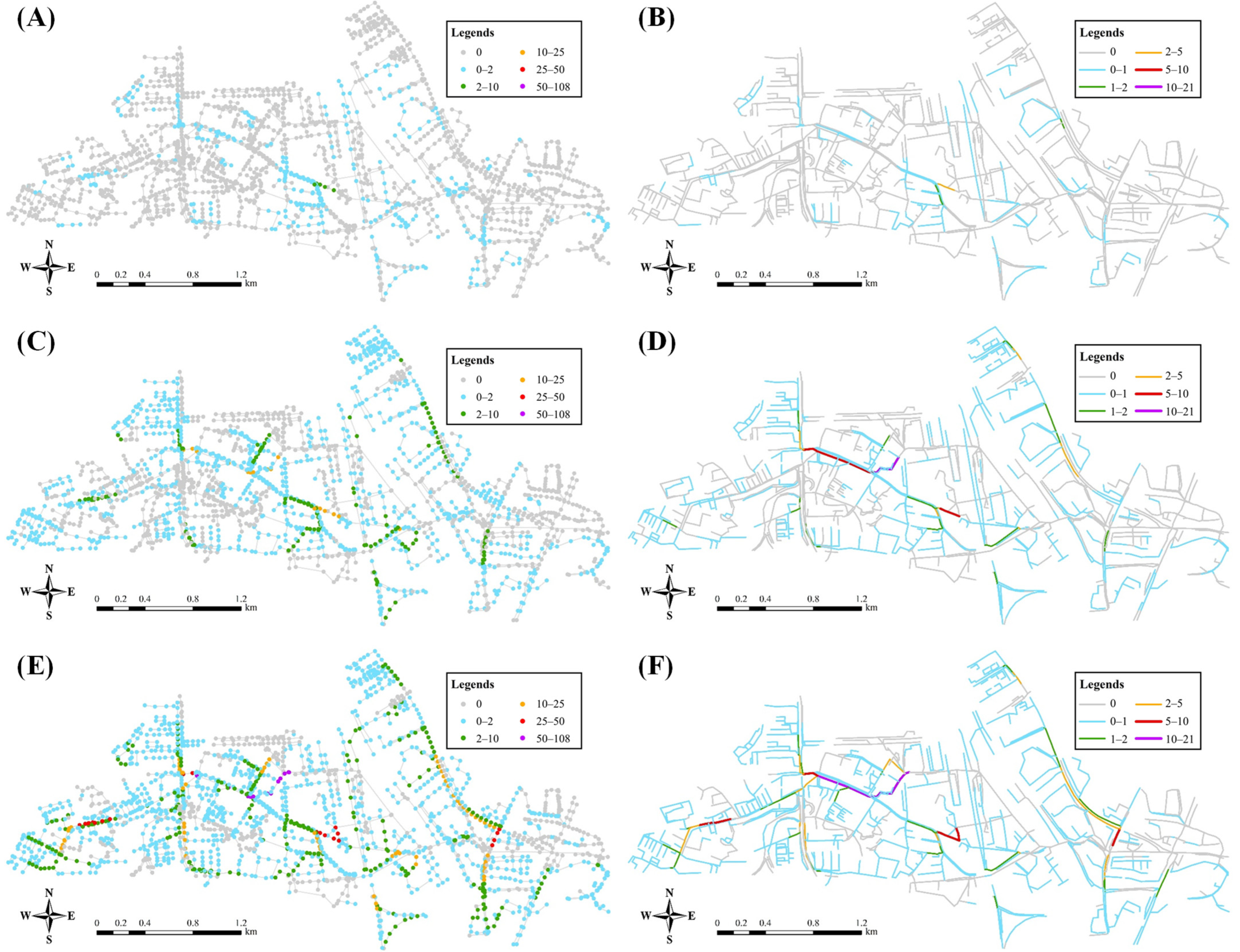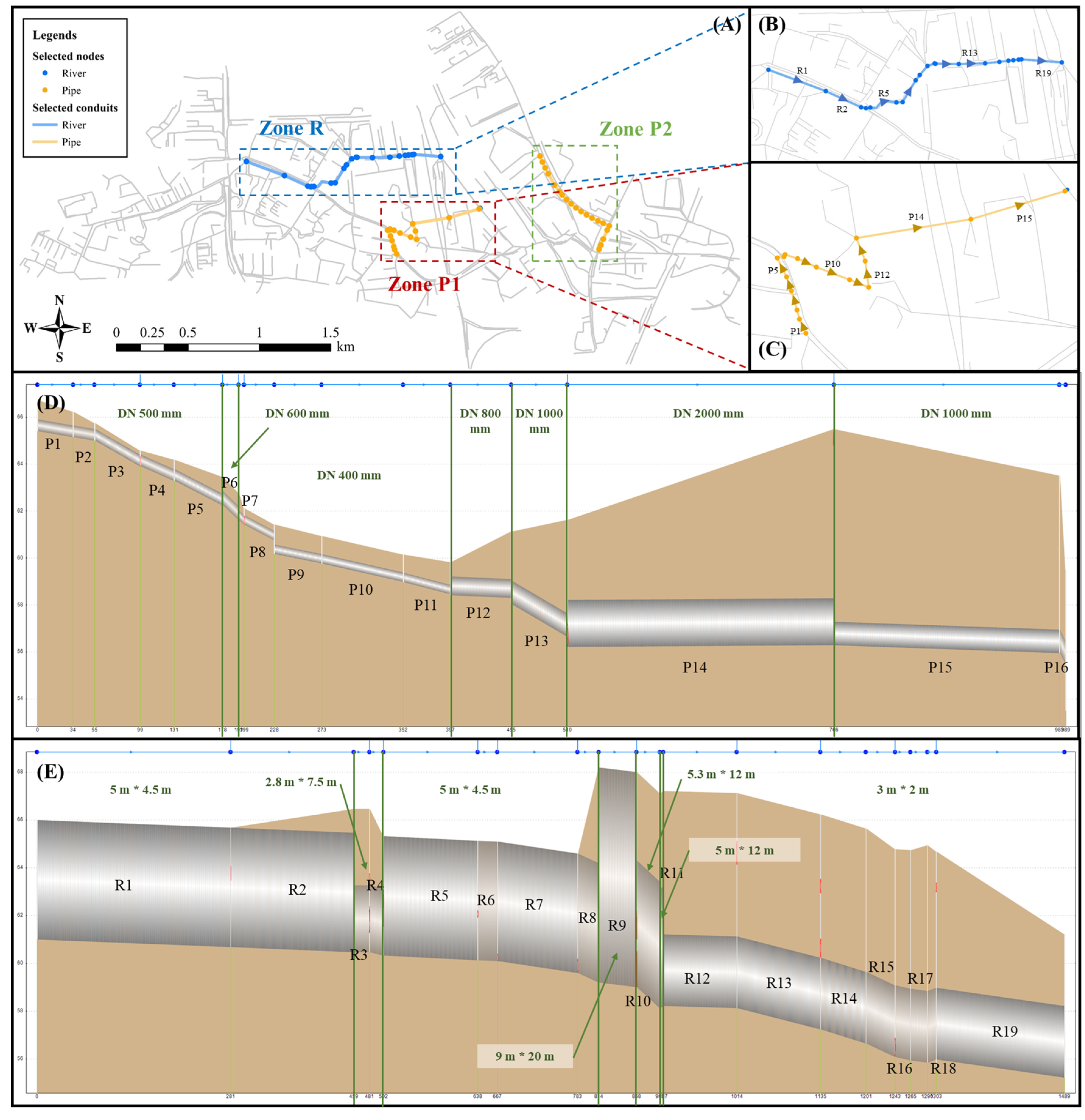Inundation Modeling and Bottleneck Identification of Pipe–River Systems in a Highly Urbanized Area
Abstract
1. Introduction
2. Data and Methods
2.1. Overview of Study Area
2.2. Data Collection
2.3. SWMM Construction
2.4. SWMM Parameter Calibration and Verification
2.5. Design Rainfall
2.6. Bottleneck Zone Identification
3. Results
3.1. Morris Sensitivity Analysis and Parameter Calibration Using GA
3.2. SWMM Verification
3.3. Evaluation of the Drainage System Performance in the Mugu River Basin
3.3.1. The Drainage Performance of the Stormwater Pipe Network
3.3.2. The Drainage Performance of the Mugu River Channels
3.4. Identification and Improvement of the Bottleneck Zones of the Drainage System
3.4.1. Bottleneck Zone Identification
3.4.2. Zone P1 Improvement
3.4.3. Zone R Improvement
4. Discussion
4.1. The Importance of Coupled Pipe–River Simulation
4.2. The Advantages of Two Metrics in Bottleneck Zone Identification
4.3. Sustainable Technical Framework for Drainage System Improvement
4.4. Limitations and Future Works
5. Conclusions
Supplementary Materials
Author Contributions
Funding
Data Availability Statement
Conflicts of Interest
Abbreviations
| CCIL | Conduit cumulative inundation length |
| GA | Genetic algorithm |
| NSE | Nash–Sutcliffe efficiency |
| NCIV | Node cumulative inundation volume |
| RMSE | Root mean square error |
| SWMM | Storm water management model |
References
- Bongaarts, J. IPCC, 2023: Climate Change 2023: Synthesis Report. Popul. Dev. Rev. 2024, 50, 577–580. [Google Scholar] [CrossRef]
- Zhuang, Q.; Liu, S.; Zhou, Z. Spatial Heterogeneity Analysis of Short-Duration Extreme Rainfall Events in Megacities in China. Water 2020, 12, 3364. [Google Scholar] [CrossRef]
- Xu, T.; Yang, Z.; Gao, X.; Zhou, J. A Study on the Evolution of Urban Underlying Surfaces and Extreme Rainfall in the Pearl River Delta. Water 2024, 16, 267. [Google Scholar] [CrossRef]
- Xu, K.; Zhuang, Y.; Bin, L.; Wang, C.; Tian, F. Impact Assessment of Climate Change on Compound Flooding in a Coastal City. J. Hydrol. 2023, 617, 129166. [Google Scholar] [CrossRef]
- Jiang, C.; Li, J.; Gao, J.; Lv, P.; Zhang, Y. Quantitative Calculation of Stormwater Regulation Capacity and Collaborative Configuration of Sponge Facilities in Urban High-Density Built-Up Areas. Environ. Sci. Pollut. Res. 2023, 30, 13571–13581. [Google Scholar] [CrossRef] [PubMed]
- Zhou, Q. A Review of Sustainable Urban Drainage Systems Considering the Climate Change and Urbanization Impacts. Water 2014, 6, 976–992. [Google Scholar] [CrossRef]
- Huang, G.R.; Wang, X.; Huang, W. Simulation of Rainstorm Water Logging in Urban Area Based on InfoWorks ICM Model. Water Resour. Power 2017, 35, 66–70. [Google Scholar] [CrossRef]
- To, T.N.; Vu, H.C.; Le, H. The Impacts of Urbanization on Urban Flooding in Danang City, Vietnam. In CIGOS 2019, Innovation for Sustainable Infrastructure, Proceedings of the 5th International Conference on Geotechnics, Civil Engineering Works and Structures; Ha-Minh, C., Dao, D.V., Benboudjema, F., Derrible, S., Huynh, D.V.K., Tang, A.M., Eds.; Springer: Singapore, 2020; pp. 1057–1062. [Google Scholar]
- Zoppou, C. Review of Urban Storm Water Models. Environ. Model. Softw. 2001, 16, 195–231. [Google Scholar] [CrossRef]
- Marsalek, J.; Dick, T.M.; Wisner, P.E.; Clarke, W.G. Comparative Evaluation of Three Urban Runoff Models. JAWRA J. Am. Water Resour. Assoc. 1975, 11, 306–328. [Google Scholar] [CrossRef]
- Chen, X.Y.; Zhang, N.; Wu, F.F. Storm Water Management Model (SWMM): Principles, Parameters and Applications. China Water Wastewater 2013, 29, 4–7. [Google Scholar] [CrossRef]
- Palaka, R.; Sri Charana Reddy, P.; Viharika, G.; Pravalika, G. Design of Urban Storm Water Drainage System Using GIS and SWMM Software. In IOP Conference Series: Materials Science and Engineering; IOP Publishing: Bristol, UK, 2021; Volume 1197, p. 012014. [Google Scholar] [CrossRef]
- El Ghazouli, K.; El Khatabi, J.; Soulhi, A.; Shahrour, I. Model Predictive Control Based on Artificial Intelligence and EPA-SWMM Model to Reduce CSOs Impacts in Sewer Systems. Water Sci. Technol. 2021, 85, 398–408. [Google Scholar] [CrossRef]
- Eskandaripour, M.; Golmohammadi, M.H.; Soltaninia, S. Optimization of Low-Impact Development Facilities in Urban Areas Using Slime Mould Algorithm. Sustain. Cities Soc. 2023, 93, 104508. [Google Scholar] [CrossRef]
- Rabori, A.M.; Ghazavi, R. Urban Flood Estimation and Evaluation of the Performance of an Urban Drainage System in a Semi-Arid Urban Area Using SWMM. Water Environ. Res. 2018, 90, 2075–2082. [Google Scholar] [CrossRef]
- Chen, X.; Davitt-Liu, I.; Erickson, A.J.; Feng, X. Integrating the Spatial Configurations of Green and Gray Infrastructure in Urban Stormwater Networks. Water Resour. Res. 2023, 59, e2023WR034796. [Google Scholar] [CrossRef]
- Liu, Y.; Zhang, X.; Liu, J.; Wang, Y.; Jia, H.; Tao, S. A Flood Resilience Assessment Method of Green-Grey-Blue Coupled Urban Drainage System Considering Backwater Effects. Ecol. Indic. 2025, 170, 113032. [Google Scholar] [CrossRef]
- Wang, T.; Zhang, L.; Zhai, J.; Wang, L.; Zhao, Y.; Liu, K. Automatic Calibration of SWMM Parameters Based on Multi-Objective Optimisation Model. J. Hydroinform. 2024, 26, 683–706. [Google Scholar] [CrossRef]
- Liu, K.; Li, J.; Gao, J.; Chi, X.; Jiang, C. Study on SWMM Calibration and Optimizing the Layout of LID Based on Intellgent Algorithm: A Case in Campus. Water Resour. Manag. 2025. [Google Scholar] [CrossRef]
- Zhang, X.; Kang, A.; Lei, X.; Wang, H. Urban Drainage Efficiency Evaluation and Flood Simulation Using Integrated SWMM and Terrain Structural Analysis. Sci. Total Environ. 2024, 957, 177442. [Google Scholar] [CrossRef]
- Yang, W.; Zheng, C.; Jiang, X.; Wang, H.; Lian, J.; Hu, D.; Zheng, A. Study on Urban Flood Simulation Based on a Novel Model of SWTM Coupling D8 Flow Direction and Backflow Effect. J. Hydrol. 2023, 621, 129608. [Google Scholar] [CrossRef]
- Akter, A.; Datta, A.; Shaharia, M. Evaluation of Urban Drainage Capacity Using Different Satellite Image Sources and SWMM. Urban Water J. 2024, 21, 1095–1108. [Google Scholar] [CrossRef]
- Li, P.; Zhou, Y.; Zhen, Y.; Jin, Q.; Meng, X. Analysis of the Influence of River Boundary Water Level on the Drainage Capacity of Pipe Network—A Case Study of Jiangnan Area in Yiwu City. In Hydraulic Structure and Hydrodynamics; Wang, W., Wang, C., Lu, Y., Eds.; Springer Nature: Singapore, 2025; pp. 425–440. ISBN 978-981-97-7251-3. [Google Scholar]
- Bertram, D.; Roberts, M.; Haynes, H. Linking Urban Drainage to Surface Water Management Models. In Environmental Hydraulics: Theoretical, Experimental and Computational Solutions; Lopez Jimenez, P., Fuertes Miquel, V., Iglesias Rey, P., Lopez Patino, G., Martinez Solano, F., Palau Salvador, G., Eds.; Routledge: London, UK, 2010; pp. 237–240. [Google Scholar]
- Cheng, S.; Yang, M.; Li, C.; Xu, H.; Chen, C.; Shu, D.; Jiang, Y.; Gui, Y.; Dong, N. An Improved Coupled Hydrologic-Hydrodynamic Model for Urban Flood Simulations under Varied Scenarios. Water Resour. Manag. 2024, 38, 5523–5539. [Google Scholar] [CrossRef]
- Wu, P.; Wang, T.; Wang, Z.; Song, C.; Chen, X. Impact of Drainage Network Structure on Urban Inundation within a Coupled Hydrodynamic Model. Water 2025, 17, 990. [Google Scholar] [CrossRef]
- Luan, G.; Hou, J.; Wang, T.; Li, D.; Zhou, Q.; Liu, L.; Duan, C. A 1D-2D Dynamic Bidirectional Coupling Model for High-Resolution Simulation of Urban Water Environments Based on GPU Acceleration Techniques. J. Clean. Prod. 2023, 428, 139494. [Google Scholar] [CrossRef]
- Chen, W.; Wu, H.; Kimball, J.S.; Alfieri, L.; Nanding, N.; Li, X.; Jiang, L.; Wu, W.; Tao, Y.; Zhao, S.; et al. A Coupled River Basin-Urban Hydrological Model (DRIVE-Urban) for Real-Time Urban Flood Modeling. Water Resour. Res. 2022, 58, e2021WR031709. [Google Scholar] [CrossRef]
- Khatooni, K.; Hooshyaripor, F.; MalekMohammadi, B.; Noori, R. A New Approach for Urban Flood Risk Assessment Using Coupled SWMM–HEC-RAS-2D Model. J. Environ. Manag. 2025, 374, 123849. [Google Scholar] [CrossRef] [PubMed]
- Feng, W.; Wang, C.; Lei, X.; Wang, H. A Simplified Modeling Approach for Optimization of Urban River Systems. J. Hydrol. 2023, 623, 129689. [Google Scholar] [CrossRef]
- Wang, H.; Lei, X.; Wang, C.; Liao, W.; Kang, A.; Huang, H.; Ding, X.; Chen, Y.; Zhang, X. A Coordinated Drainage and Regulation Model of Urban Water Systems in China: A Case Study in Fuzhou City. River 2023, 2, 5–20. [Google Scholar] [CrossRef]
- Venn, A. 24—Social Justice and Climate Change. In Managing Global Warming; Letcher, T.M., Ed.; Academic Press: Cambridge, MA, USA, 2019; pp. 711–728. ISBN 978-0-12-814104-5. [Google Scholar]
- Spijkers, O. Intergenerational Equity and the Sustainable Development Goals. Sustainability 2018, 10, 3836. [Google Scholar] [CrossRef]
- Rentachintala, L.R.N.P.; Reddy, M.G.M.; Mohapatra, P.K. Urban Stormwater Management for Sustainable and Resilient Measures and Practices: A Review. Water Sci. Technol. 2022, 85, 1120–1140. [Google Scholar] [CrossRef]
- Tang, L.L.; Hu, J.C.; Liu, Z.; Yang, Z.G.; Li, Q.Q. Bottleneck Analysis and Reform Evaluation of Urban Underground Drainage Pipe Network Based on SWMM. China Water Wastewater 2018, 34, 112–117. [Google Scholar] [CrossRef]
- Liao, W.L.; Zhou, X.W.; Wang, C.H.; Wang, Z.L. Simulation and Application on Storm Flood in Dongguan City Based on SWMM. In Proceedings of the 2014 International Conference on Mechatronics, Electronic, Industrial and Control Engineering, Shenyang, China, 29–31 August 2014. [Google Scholar]
- Wei, Z.Q.; Huang, Y.J.; Lin, L.N.; Lu, L.J.; Huang, X.F. Application of InfoWorks ICM in Problem Diagnosis and Reconstruction of Drainage Pipe Network for Urban Build-up Area. China Water Wastewater 2017, 33, 115–119. [Google Scholar] [CrossRef]
- Osheen; Kansal, M.L.; Bisht, D.S. Evaluation of an Urban Drainage System Using Functional and Structural Resilience Approach. Urban Water J. 2023, 20, 1794–1812. [Google Scholar] [CrossRef]
- Zuo, C.; Yin, B.; Tan, F.; Ma, Z.; Gong, S.; Qi, X. Runoff Simulation and Waterlogging Analysis of Rainstorm Scenarios with Different Return Periods on Campus: A Case Study at China University of Geosciences. Appl. Sci. 2025, 15, 691. [Google Scholar] [CrossRef]
- Liu, Y.; Zhao, W.; Wei, Y.; Sebastian, F.S.M.; Wang, M. Urban Waterlogging Control: A Novel Method to Urban Drainage Pipes Reconstruction, Systematic and Automated. J. Clean. Prod. 2023, 418, 137950. [Google Scholar] [CrossRef]
- Ahmad, S.; Jia, H.; Ashraf, A.; Yin, D.; Chen, Z.; Ahmed, R.; Israr, M. A Novel GIS-SWMM-ABM Approach for Flood Risk Assessment in Data-Scarce Urban Drainage Systems. Water 2024, 16, 1464. [Google Scholar] [CrossRef]
- Katoch, S.; Chauhan, S.S.; Kumar, V. A Review on Genetic Algorithm: Past, Present, and Future. Multimed. Tools Appl. 2021, 80, 8091–8126. [Google Scholar] [CrossRef]
- Kumar, S.; Kaushal, D.R.; Gosain, A.K. Evaluation of Evolutionary Algorithms for the Optimization of Storm Water Drainage Network for an Urbanized Area. Acta Geophys. 2019, 67, 149–165. [Google Scholar] [CrossRef]
- Lamontagne, J.R.; Barber, C.A.; Vogel, R.M. Improved Estimators of Model Performance Efficiency for Skewed Hydrologic Data. Water Resour. Res. 2020, 56, e2020WR027101. [Google Scholar] [CrossRef]
- McDonnell, B.; Ratliff, K.; Tryby, M.; Wu, J.; Mullapudi, A. PySWMM: The Python Interface to Stormwater Management Model (SWMM). J. Open Source Softw. 2020, 5, 2292. [Google Scholar] [CrossRef]
- Liu, Y.Y.; Li, L.; Liu, Y.S.; Chan, P.W.; Zhang, W.-H. Dynamic Spatial-Temporal Precipitation Distribution Models for Short-Duration Rainstorms in Shenzhen, China Based on Machine Learning. Atmos. Res. 2020, 237, 104861. [Google Scholar] [CrossRef]
- Zhong, B.; Wang, Z.; Yang, H.; Xu, H.; Gao, M.; Liang, Q. Parameter Optimization of SWMM Model Using Integrated Morris and GLUE Methods. Water 2022, 15, 149. [Google Scholar] [CrossRef]
- Kim, S.W.; Kwon, S.H.; Jung, D. Development of a Multi-Objective Automatic Parameter-Calibration Framework for Urban Drainage Systems. Sustainability 2022, 14, 8350. [Google Scholar] [CrossRef]
- McCall, J. Genetic Algorithms for Modelling and Optimization. J. Comput. Appl. Math. 2005, 184, 205–222. [Google Scholar] [CrossRef]
- Assarkhaniki, Z.; Sabri, S.; Rajabifard, A.; Kahalimoghadam, M. Advancing sustainable development goals: Embedding resilience assessment. Sustain. Sci. 2023, 18, 2405–2421. [Google Scholar] [CrossRef]
- Research Institute of Standards and Norms Ministry of Housing and Urban-Rural Development. Investment Estimation Index for Municipal Engineering; China Planning Press: Beijing, China, 2007; Volume 4, ISBN 978-7-80242-076-2. [Google Scholar]






| No. | Parameters | Value Ranges | Input Values | Calibration Results |
|---|---|---|---|---|
| 1 | Manning roughness coefficient of impervious area (N-Imperv) | 0.011~0.033 | 0.021 | 0.03 |
| 2 | Manning roughness coefficient of permeable area (N-Perv) | 0.05~0.8 | 0.45 | 0.66 |
| 3 | Depression storage depth of impervious area (S-Imperv)/mm | 0.2~10 | 5 | 0.2 |
| 4 | Depression storage depth of permeable area (S-Perv)/mm | 2~10 | 5 | 7.4 |
| 5 | Percentage of impermeable area without depression storage (PctZero)/% | 5~85 | 45 | 75 |
| 6 | Maximum infiltration rate (MaxRate)/(mm/h) | 25~80 | 55 | 79 |
| 7 | Minimum infiltration rate (MinRate)/(mm/h) | 0~10 | 5 | 9.5 |
| 8 | Decay rate constant (Decay)/(1/h) | 2~7 | 4 | 2.75 |
| 9 | Drainage time (Drytime)/d | 1~7 | 4 | 1 |
| 10 | Manning roughness coefficient of conduits (manningN_pipe) | 0.011~0.025 | 0.017 | 0.016 |
| 11 | Manning roughness coefficient of river (manningN_river) | 0.011~0.025 | 0.017 | 0.024 |
Disclaimer/Publisher’s Note: The statements, opinions and data contained in all publications are solely those of the individual author(s) and contributor(s) and not of MDPI and/or the editor(s). MDPI and/or the editor(s) disclaim responsibility for any injury to people or property resulting from any ideas, methods, instructions or products referred to in the content. |
© 2025 by the authors. Licensee MDPI, Basel, Switzerland. This article is an open access article distributed under the terms and conditions of the Creative Commons Attribution (CC BY) license (https://creativecommons.org/licenses/by/4.0/).
Share and Cite
Chen, J.; Shang, F.; Fu, H.; Yu, Y.; Wang, H.; Qin, H.; Ping, Y. Inundation Modeling and Bottleneck Identification of Pipe–River Systems in a Highly Urbanized Area. Sustainability 2025, 17, 7065. https://doi.org/10.3390/su17157065
Chen J, Shang F, Fu H, Yu Y, Wang H, Qin H, Ping Y. Inundation Modeling and Bottleneck Identification of Pipe–River Systems in a Highly Urbanized Area. Sustainability. 2025; 17(15):7065. https://doi.org/10.3390/su17157065
Chicago/Turabian StyleChen, Jie, Fangze Shang, Hao Fu, Yange Yu, Hantao Wang, Huapeng Qin, and Yang Ping. 2025. "Inundation Modeling and Bottleneck Identification of Pipe–River Systems in a Highly Urbanized Area" Sustainability 17, no. 15: 7065. https://doi.org/10.3390/su17157065
APA StyleChen, J., Shang, F., Fu, H., Yu, Y., Wang, H., Qin, H., & Ping, Y. (2025). Inundation Modeling and Bottleneck Identification of Pipe–River Systems in a Highly Urbanized Area. Sustainability, 17(15), 7065. https://doi.org/10.3390/su17157065






